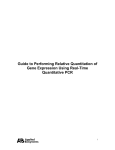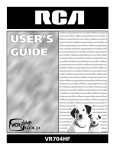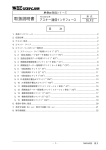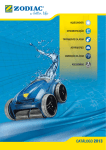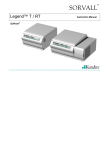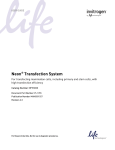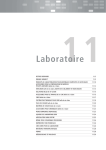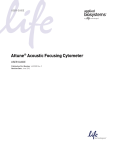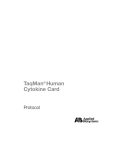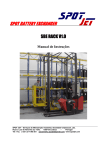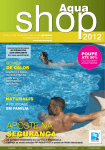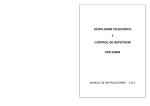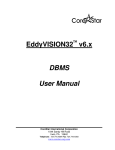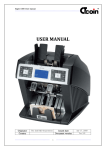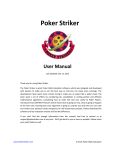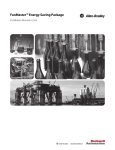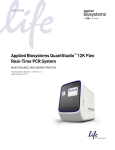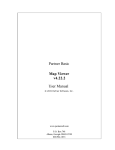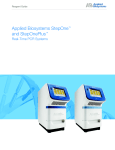Download TaqMan® Array Micro Fluidic Cards
Transcript
User Guide TaqMan® Array Micro Fluidic Cards User Guide Introduction TaqMan® Array Micro Fluidic Cards Order the TaqMan® Array Micro Fluidic Card Prepare Your Samples Perform the Experiment For Research Use Only. Not for use in diagnostic procedures. Information in this document is subject to change without notice. Applied Biosystems assumes no responsibility for any errors that may appear in this document. APPLIED BIOSYSTEMS DISCLAIMS ALL WARRANTIES WITH RESPECT TO THIS DOCUMENT, EXPRESSED OR IMPLIED, INCLUDING BUT NOT LIMITED TO THOSE OF MERCHANTABILITY OR FITNESS FOR A PARTICULAR PURPOSE. IN NO EVENT SHALL APPLIED BIOSYSTEMS BE LIABLE, WHETHER IN CONTRACT, TORT, WARRANTY, OR UNDER ANY STATUTE OR ON ANY OTHER BASIS FOR SPECIAL, INCIDENTAL, INDIRECT, PUNITIVE, MULTIPLE OR CONSEQUENTIAL DAMAGES IN CONNECTION WITH OR ARISING FROM THIS DOCUMENT, INCLUDING BUT NOT LIMITED TO THE USE THEREOF. NOTICE TO PURCHASER: LIMITED LICENSE A license to perform the patented 5′ Nuclease Process for research is obtained by the purchase of (i) both Licensed Probe and Authorized 5′ Nuclease Core Kit, (ii) a Licensed 5′ Nuclease Kit, or (iii) license rights from Applied Biosystems. The TaqMan® Array Micro Fluidic Card contains Licensed Probe. Use of this product is covered by US patent claims and corresponding patent claims outside the US. The purchase of this product includes a limited, non-transferable immunity from suit under the foregoing patent claims for using only this amount of product for the purchaser’s own internal research. The right to use this product in the 5′ Nuclease Process under the applicable claims of US patents, and corresponding patent claims outside the United States, can be obtained through purchase of an Authorized 5′ Nuclease Core Kit. Except under separate license rights available from Applied Biosystems, no right under any other patent claim, or to perform commercial services of any kind, including without limitation reporting the results of purchaser’s activities for a fee or other commercial consideration, or to sublicense, repackage with other products, or resell in any form, is conveyed expressly, by implication, or by estoppel. This product is for research use only. Diagnostic uses under Roche patents require a separate license from Roche. Further information on purchasing licenses may be obtained from the Director of Licensing, Applied Biosystems, 850 Lincoln Centre Drive, Foster City, California 94404, USA. TRADEMARKS: © 2009, 2010 Life Technologies Corporation. All rights reserved. Trademarks of Life Technologies Corporation and its affiliated companies: AB (Design)®, ABI PRISM®, Applied Biosystems®, Cells-to-CT™, FAM™, ROX™. AmpErase and TaqMan are registered trademarks of Roche Molecular Systems, Inc. Excel and Microsoft are registered trademarks of Microsoft Corporation. StatMiner is a trademark of Integromics. All other trademarks are the sole property of their respective owners. Part Number 4400263 Rev. C 07/2010 Contents Preface . . . . . . . . . . . . . . . . . . . . . . . . . . . . . . . . . . . . . . . . . . . . . v How to Use This Guide . . . . . . . . . . . . . . . . . . . . . . . . . . . . . . . . . . . . . . . . . . . . . . . . . v How to Obtain More Information . . . . . . . . . . . . . . . . . . . . . . . . . . . . . . . . . . . . . . . . . vi How to Obtain Support . . . . . . . . . . . . . . . . . . . . . . . . . . . . . . . . . . . . . . . . . . . . . . . . vii Important Safety Information . . . . . . . . . . . . . . . . . . . . . . . . . . . ix Safety Alert Words . . . . . . . . . . . . . . . . . . . . . . . . . . . . . . . . . . . . . . . . . . . . . . . . . . . . . x Chemical Safety Guidelines . . . . . . . . . . . . . . . . . . . . . . . . . . . . . . . . . . . . . . . . . . . . . . x About MSDSs . . . . . . . . . . . . . . . . . . . . . . . . . . . . . . . . . . . . . . . . . . . . . . . . . . . . . . . . xi Chemical Waste Safety Guidelines . . . . . . . . . . . . . . . . . . . . . . . . . . . . . . . . . . . . . . . xii Waste Disposal . . . . . . . . . . . . . . . . . . . . . . . . . . . . . . . . . . . . . . . . . . . . . . . . . . . . . . . xii Biological Hazard Safety . . . . . . . . . . . . . . . . . . . . . . . . . . . . . . . . . . . . . . . . . . . . . . xiii Chapter 1 Introduction . . . . . . . . . . . . . . . . . . . . . . . . . . . . . . . . . . . . . . . . . 1 Product Overview . . . . . . . . . . . . . . . . . . . . . . . . . . . . . . . . . . . . . . . . . . . . . . . . . . . . . . 2 Instrument Overview . . . . . . . . . . . . . . . . . . . . . . . . . . . . . . . . . . . . . . . . . . . . . . . . . . . 5 User Guide Overview . . . . . . . . . . . . . . . . . . . . . . . . . . . . . . . . . . . . . . . . . . . . . . . . . . . 6 Chapter 2 Order the TaqMan® Array Micro Fluidic Card . . . . . . . . . . . . . . 9 Order the TaqMan® Array Micro Fluidic Card . . . . . . . . . . . . . . . . . . . . . . . . . . . . . . . . 10 Available Formats . . . . . . . . . . . . . . . . . . . . . . . . . . . . . . . . . . . . . . . . . . . . . . . . . . . . . 22 Array Information CD . . . . . . . . . . . . . . . . . . . . . . . . . . . . . . . . . . . . . . . . . . . . . . . . . . 26 Chapter 3 Prepare Your Samples . . . . . . . . . . . . . . . . . . . . . . . . . . . . . . . . 31 Prepare Your Samples . . . . . . . . . . . . . . . . . . . . . . . . . . . . . . . . . . . . . . . . . . . . . . . . . 32 Store the cDNA Samples . . . . . . . . . . . . . . . . . . . . . . . . . . . . . . . . . . . . . . . . . . . . . . . 34 Chapter 4 Perform the Experiment . . . . . . . . . . . . . . . . . . . . . . . . . . . . . . . 35 Prepare the TaqMan® Array Micro Fluidic Card . . . . . . . . . . . . . . . . . . . . . . . . . . . . . . 36 Run the TaqMan® Array Micro Fluidic Card . . . . . . . . . . . . . . . . . . . . . . . . . . . . . . . . . 46 Analyze the Experiment . . . . . . . . . . . . . . . . . . . . . . . . . . . . . . . . . . . . . . . . . . . . . . . . 50 TaqMan® Array Micro Fluidic Cards User Guide iii Contents Appendix A Troubleshooting . . . . . . . . . . . . . . . . . . . . . . . . . . . . . . . . . . . . . 53 Appendix B TaqMan® Endogenous Control Assays . . . . . . . . . . . . . . . . . . . 57 Appendix C Required Materials . . . . . . . . . . . . . . . . . . . . . . . . . . . . . . . . . . . 59 For Preparing Your Samples . . . . . . . . . . . . . . . . . . . . . . . . . . . . . . . . . . . . . . . . . . . . 60 For Preparing the TaqMan® Array Micro Fluidic Card . . . . . . . . . . . . . . . . . . . . . . . . . 61 For Running and Analyzing the TaqMan® Array Micro Fluidic Card . . . . . . . . . . . . . . 62 For General Use . . . . . . . . . . . . . . . . . . . . . . . . . . . . . . . . . . . . . . . . . . . . . . . . . . . . . 63 Appendix D Prevent Contamination . . . . . . . . . . . . . . . . . . . . . . . . . . . . . . . . 65 Index . . . . . . . . . . . . . . . . . . . . . . . . . . . . . . . . . . . . . . . . . . . . . . 67 iv TaqMan® Array Micro Fluidic Cards User Guide Preface How to Use This Guide Purpose of This Guide The Applied Biosystems TaqMan® Array Micro Fluidic Cards User Guide provides information for ordering TaqMan® Array Micro Fluidic Cards, preparing and running the TaqMan Array cards on an Applied Biosystems 7900HT Fast Real-Time PCR System, then analyzing the results. Audience This guide is intended for novice and experienced 7900HT Fast System users who perform quantitation experiments with the TaqMan Array cards using the comparative CT (ΔΔCT) method. Text Conventions This guide uses the following conventions: • Bold text indicates user action. For example: Type 0, then press Enter for each of the remaining fields. • Italic text indicates new or important words and is also used for emphasis. For example: Before running, always prepare fresh master mix. • A right arrow symbol () separates successive commands you select from a dropdown or shortcut menu. For example: Select FileOpen. User Attention Words Two user attention words appear in Applied Biosystems user documentation. Each word implies a particular level of observation or action as described below: Note: – Provides information that may be of interest or help but is not critical to the use of the product. IMPORTANT! – Provides information that is necessary for proper instrument operation, accurate chemistry kit use, or safe use of a chemical. Examples of the user attention words appear below: Note: There is a fill port on the left arm of each fill reservoir; it is the larger of the two holes. IMPORTANT! When performing reverse transcription, do not exceed the amounts of total RNA recommended in the kit protocol. TaqMan® Array Micro Fluidic Cards User Guide v Preface How to Obtain More Information Safety Alert Words Safety alert words also appear in user documentation. For more information, see “Safety Alert Words” on page x. How to Obtain More Information Related Documentation In addition to this guide, the TaqMan® Array Micro Fluidic Cards User Guide (PN 4400263), the documents listed below are available from Applied Biosystems. To obtain this and additional documentation, see “How to Obtain Support” on page vii. Title vi Part Number Amplification Efficiency of TaqMan® Gene Expression Assays 127AP05 Applied Biosystems 7900HT Fast Real-Time PCR System and SDS Enterprise Database User Guide 4351684 Applied Biosystems 7900HT Fast Real-Time PCR System Relative Quantitation Using Comparative CT Getting Started Guide 4364016 Applied Biosystems 7900HT Fast Real-Time PCR System Site Preparation Guide 4351923 Applied Biosystems Real-Time PCR Systems Reagent Guide 4387787 High-Capacity cDNA Reverse Transcription Kits Protocol 4375575 High Capacity RNA-to-cDNA Kit Protocol 4387951 High Capacity RNA-to-cDNA Master Mix Protocol 4377474 TaqMan® Gene Expression Assays Protocol 4333458 TaqMan® Gene Expression Cells-to-CT™ Kit Protocol 4385117 TaqMan® Gene Expression Master Mix Protocol 4371135 TaqMan® PreAmp Master Mix Kit Protocol 4384557 TaqMan® Universal PCR Master Mix Protocol 4304449 User Bulletin #2: Relative Quantitation of Gene Expression 4303859 Using TaqMan® Endogenous Control Assays to Select an Endogenous Control for Experimental Studies (Application Note) 127AP08 TaqMan® Array Micro Fluidic Cards User Guide Preface How to Obtain Support Obtaining Information from the Help System The SDS software Help system describes how to use each feature of the user interface. To access the Help system, you can: • Click in the toolbar • Select HelpSDS Online Help • Press F1 To find topics of interest in the Help system, you can: • Review the table of contents • Search for a specific topic • Search an alphabetized index Send Us Your Comments Applied Biosystems welcomes your comments and suggestions for improving its user documents. You can e-mail your comments to: [email protected] IMPORTANT! The e-mail address above is only for submitting comments and suggestions relating to documentation. To order documents, download PDF files, or for help with a technical question, go to www.appliedbiosystems.com, then click the link for Support. (See “How to Obtain Support” below). How to Obtain Support For the latest services and support information for all locations, go to www.appliedbiosystems.com, then click the link for Support. At the Support page, you can: • Access worldwide telephone and fax numbers to contact Applied Biosystems Technical Support and Sales facilities • Search through frequently asked questions (FAQs) • Submit a question directly to Technical Support • Order Applied Biosystems user documents, MSDSs, certificates of analysis, and other related documents • Download PDF documents • Obtain information about customer training • Download software updates and patches TaqMan® Array Micro Fluidic Cards User Guide vii Preface How to Obtain Support viii TaqMan® Array Micro Fluidic Cards User Guide Important Safety Information This section covers: ■ Safety Alert Words . . . . . . . . . . . . . . . . . . . . . . . . . . . . . . . . . . . . . . . . . . . . . . . . . . x ■ Chemical Safety Guidelines . . . . . . . . . . . . . . . . . . . . . . . . . . . . . . . . . . . . . . . . . . . x ■ About MSDSs . . . . . . . . . . . . . . . . . . . . . . . . . . . . . . . . . . . . . . . . . . . . . . . . . . . . . xi ■ Chemical Waste Safety Guidelines. . . . . . . . . . . . . . . . . . . . . . . . . . . . . . . . . . . . . xii ■ Waste Disposal . . . . . . . . . . . . . . . . . . . . . . . . . . . . . . . . . . . . . . . . . . . . . . . . . . . . xii ■ Biological Hazard Safety . . . . . . . . . . . . . . . . . . . . . . . . . . . . . . . . . . . . . . . . . . . xiii TaqMan® Array Micro Fluidic Cards User Guide ix Important Safety Information Safety Alert Words Safety Alert Words Four safety alert words appear in Applied Biosystems user documentation at points in the document where you need to be aware of relevant hazards. Each alert word—IMPORTANT, CAUTION, WARNING, DANGER—implies a particular level of observation or action, as defined below. Definitions IMPORTANT! – Indicates information that is necessary for proper instrument operation, accurate chemistry kit use, or safe use of a chemical. – Indicates a potentially hazardous situation that, if not avoided, may result in minor or moderate injury. It may also be used to alert against unsafe practices. – Indicates a potentially hazardous situation that, if not avoided, could result in death or serious injury. – Indicates an imminently hazardous situation that, if not avoided, will result in death or serious injury. This signal word is to be limited to the most extreme situations. Chemical Hazard Warning CHEMICAL HAZARD. Some of the chemicals used with Applied Biosystems instruments and protocols are potentially hazardous and can cause injury, illness, or death. Chemical Safety Guidelines To minimize the hazards of chemicals: • Read and understand the Material Safety Data Sheets (MSDSs) provided by the chemical manufacturer before you store, handle, or work with any chemicals or hazardous materials. (See “About MSDSs” on page xi.) • Minimize contact with chemicals. Wear appropriate personal protective equipment when handling chemicals (for example, safety glasses, gloves, or protective clothing). For additional safety guidelines, consult the MSDS. • Minimize the inhalation of chemicals. Do not leave chemical containers open. Use only with adequate ventilation (for example, fume hood). For additional safety guidelines, consult the MSDS. • Check regularly for chemical leaks or spills. If a leak or spill occurs, follow the manufacturer’s cleanup procedures as recommended in the MSDS. • Comply with all local, state/provincial, or national laws and regulations related to chemical storage, handling, and disposal. x TaqMan® Array Micro Fluidic Cards User Guide Important Safety Information About MSDSs About MSDSs Chemical manufacturers supply current Material Safety Data Sheets (MSDSs) with shipments of hazardous chemicals to new customers. They also provide MSDSs with the first shipment of a hazardous chemical to a customer after an MSDS has been updated. MSDSs provide the safety information you need to store, handle, transport, and dispose of the chemicals safely. Each time you receive a new MSDS packaged with a hazardous chemical, be sure to replace the appropriate MSDS in your files. Obtaining MSDSs The MSDS for any chemical supplied by Applied Biosystems is available to you free 24 hours a day. To obtain MSDSs: 1. Go to www.appliedbiosystems.com, click Support, then click MSDS Search. 2. In the Keyword Search field, enter the chemical name, product name, MSDS part number, or other information that appears in the MSDS of interest. Select the language of your choice, then click Search. 3. Find the document of interest, right-click the document title, then select any of the following: • Open – To view the document • Print Target – To print the document • Save Target As – To download a PDF version of the document to a destination that you choose Note: For the MSDSs of chemicals not distributed by Applied Biosystems, contact the chemical manufacturer. TaqMan® Array Micro Fluidic Cards User Guide xi Important Safety Information Chemical Waste Safety Guidelines Chemical Waste Safety Guidelines To minimize the hazards of chemical waste: • Read and understand the Material Safety Data Sheets (MSDSs) provided by the manufacturers of the chemicals in the waste container before you store, handle, or dispose of chemical waste. • Provide primary and secondary waste containers. (A primary waste container holds the immediate waste. A secondary container contains spills or leaks from the primary container. Both containers must be compatible with the waste material and meet federal, state, and local requirements for container storage.) • Minimize contact with chemicals. Wear appropriate personal protective equipment when handling chemicals (for example, safety glasses, gloves, or protective clothing). For additional safety guidelines, consult the MSDS. • Minimize the inhalation of chemicals. Do not leave chemical containers open. Use only with adequate ventilation (for example, fume hood).For additional safety guidelines, consult the MSDS. • Handle chemical wastes in a fume hood. • After emptying the waste container, seal it with the cap provided. • Dispose of the contents of the waste tray and waste bottle in accordance with good laboratory practices and local, state/provincial, or national environmental and health regulations. Waste Disposal If potentially hazardous waste is generated when you operate the instrument, you must: • Characterize (by analysis if necessary) the waste generated by the particular applications, reagents, and substrates used in your laboratory. • Ensure the health and safety of all personnel in your laboratory. • Ensure that the instrument waste is stored, transferred, transported, and disposed of according to all local, state/provincial, and/or national regulations. IMPORTANT! Radioactive or biohazardous materials may require special handling, and disposal limitations may apply. xii TaqMan® Array Micro Fluidic Cards User Guide Important Safety Information Biological Hazard Safety Biological Hazard Safety BIOHAZARD. Biological samples such as tissues, body fluids, infectious agents, and blood of humans and other animals have the potential to transmit infectious diseases. Follow all applicable local, state/provincial, and/or national regulations. Wear appropriate protective equipment, which includes but is not limited to: protective eyewear, face shield, clothing/lab coat, and gloves. All work should be conducted in properly equipped facilities using the appropriate safety equipment (for example, physical containment devices). Individuals should be trained according to applicable regulatory and company/institution requirements before working with potentially infectious materials. Read and follow the applicable guidelines and/or regulatory requirements in the following: • U.S. Department of Health and Human Services guidelines published in Biosafety in Microbiological and Biomedical Laboratories (stock no. 017-040-00547-4; bmbl.od.nih.gov) • Occupational Safety and Health Standards, Bloodborne Pathogens (29 CFR§1910.1030; www.access.gpo.gov/nara/cfr/waisidx_01/ 29cfr1910a_01.html). • Your company’s/institution’s Biosafety Program protocols for working with/handling potentially infectious materials. Additional information about biohazard guidelines is available at www.cdc.gov. TaqMan® Array Micro Fluidic Cards User Guide xiii Important Safety Information Biological Hazard Safety xiv TaqMan® Array Micro Fluidic Cards User Guide Chapter 1 Introduction 1 This chapter covers: ■ Product Overview . . . . . . . . . . . . . . . . . . . . . . . . . . . . . . . . . . . . . . . . . . . . . . . . . . . 2 ■ Instrument Overview . . . . . . . . . . . . . . . . . . . . . . . . . . . . . . . . . . . . . . . . . . . . . . . . 5 ■ User Guide Overview . . . . . . . . . . . . . . . . . . . . . . . . . . . . . . . . . . . . . . . . . . . . . . . . 6 TaqMan® Array Micro Fluidic Cards User Guide 1 1 Chapter 1 Introduction Product Overview Product Overview About TaqMan® Array Micro Fluidic Cards TaqMan® Array Micro Fluidic Cards are 384-well cards preloaded with TaqMan® Gene Expression Assays. The TaqMan Array cards allow you to measure gene expression using the comparative CT (ΔΔCT) method of relative quantitation. You can run 1 to 8 samples per card, against 12 to 384 TaqMan Gene Expression Assay targets (including controls). Three types of TaqMan Array cards are available from Applied Biosystems: • TaqMan® Array Custom Micro Fluidic Card – Customizable card–you choose the assays to include in your card. Select TaqMan Gene Expression Assays from Applied Biosystems collection of Inventoried assays. The TaqMan Array Custom Micro Fluidic Cards are manufactured when ordered. • TaqMan® Gene Sets – Customizable card–you choose the assays to include in your card. The TaqMan Gene Sets are a collection of TaqMan Gene Expression Assays that define specific target classes, pathways, or diseases (for example, the TaqMan® Array Human Apoptosis Micro Fluidic Card). Select assays from the TaqMan Gene Sets, then customize the card according to your research needs. TaqMan Array cards with TaqMan Gene Sets are manufactured when ordered. Note: You can substitute assays within a TaqMan Gene Set with TaqMan Gene Expression Assays from Applied Biosystems collection of Inventoried assays. • TaqMan® Gene Signature Array – Preconfigured card. The TaqMan Gene Signature Arrays contain preselected TaqMan Gene Expression Assays that target specific gene classes (for example, Human Stem Cell Pluripotency markers). The TaqMan Gene Signature Arrays are manufactured and placed in inventory. A complete list of the TaqMan Gene Expression Assays that are available for each type of TaqMan Array card can be found on the Applied Biosystems web site. For ordering information, see Chapter 2 on page 9. Key Features • Small-volume design minimizes sample and reagent consumption. • Streamlined reaction setup saves time and reduces labor-intensive steps. • Provides access to high-throughput, 384-well format without liquid-handling robotics. • Detects two-fold discrimination at the 99.7% confidence level. • Provides standardization across multiple samples in multiple laboratories. For More Information For more information on relative quantitation, refer to User Bulletin #2: Relative Quantitation of Gene Expression. Notes 2 TaqMan® Array Micro Fluidic Cards User Guide Chapter 1 Introduction Product Overview About TaqMan® Gene Expression Assays 1 TaqMan Gene Expression Assays are a comprehensive collection of Inventoried and Made to Order Assays (probe and primer sets) for performing quantitation experiments on genes from several species. Note: Only Inventoried Assays can be placed onto a TaqMan Array card. If you require a Made to Order Assay, please contact your local Applied Biosystems Sales Representative. The TaqMan Gene Expression Assays: • Use TaqMan® reagents (5′ nuclease chemistry) to amplify and detect the target in cDNA samples. • When possible, can amplify target cDNA without amplifying genomic DNA. The suffix of the assay ID indicates the assay placement (and thus, genomic DNA detection); see “Detection of genomic DNA During Amplification” on page 33. • Consist of two unlabeled primers and one 6-FAM™ dye-labeled, TaqMan® MGB probe The TaqMan Gene Expression Assays are: • Designed with an automated design system. • Designed and optimized to work with an Applied Biosystems TaqMan® master mix using universal thermal cycling conditions. • Preformulated and ready to use. Efficiency of TaqMan Gene Expression Assays A statistically significant number of TaqMan Gene Expression Assays have been tested for PCR efficiency. When tested across a 6-log range, all assays approached 100% efficiency (±10%). Refer to the Application Note Amplification Efficiency of TaqMan® Gene Expression Assays for validation information. Note: Applied Biosystems does not recommend that you test assay efficiency on the TaqMan Array cards. In order to calculate the efficiency correctly, a dilution series with a minimum of 5 orders of magnitude must be used. With cDNA samples, in most cases it is not possible to obtain results over such a large dynamic range, potentially leading to inaccurate results. Notes TaqMan® Array Micro Fluidic Cards User Guide 3 1 Chapter 1 Introduction Product Overview Applications The TaqMan Array cards are recommended for use: • In relative quantitation experiments using the comparative CT (ΔΔCT) method. • With singleplex PCR. A single primer/probe set is present in each well of the TaqMan Array card. Only one target can be amplified per well. • In 2-step RT-PCR: – In the reverse-transcription (RT) step, you convert total RNA to cDNA. To perform reverse-transcription, Applied Biosystems recommends the High Capacity cDNA Reverse Transcription Kit or the High Capacity RNA-tocDNA Kit. – In the PCR step, you combine your cDNA samples and a TaqMan® master mix, add this reaction mix to the TaqMan Array card, then run the card on a 7900HT Fast Real-Time PCR System. The instrument must have a TaqMan® Array Micro Fluidic Card Thermal Cycling Block installed. During PCR, the 7900HT Fast System detects the real-time amplification of your targets, then determines relative levels of gene expression from the fluorescence data that are generated during PCR. TaqMan® Array Micro Fluidic Card Diagram Fill reservoir (1 of 8) – A reservoir for the sample before it is centrifugally transferred into the wells. See below for an enlarged view of the fill reservoir. Fill strip – The segment of the TaqMan Array card that contains the eight fill reservoirs. After the card is centrifuged and sealed, you trim off the fill strip. Barcode – For each TaqMan Array card, a unique identifier that can be scanned into database systems for tracking. GR2156a The fill reservoir includes a fill port on the left, and a vent port on the right. Use the fill port to add reaction mix to the TaqMan Array card. Fill port Vent port GR2158 Notes 4 TaqMan® Array Micro Fluidic Cards User Guide Chapter 1 Introduction Instrument Overview 1 Instrument Overview The TaqMan Array cards must be: • Centrifuged with a Sorvall® or Heraeus centrifuge. • Sealed with a TaqMan® Array Micro Fluidic Card Sealer, then trimmed. • Run on an Applied Biosystems 7900HT Fast Real-Time PCR System. The instrument must have a TaqMan® Array Micro Fluidic Card Thermal Cycling Block installed. Required Components Instrument Sorvall® or Heraeus centrifuge Component Sorvall/Heraeus Custom Buckets Card holders Applied Biosystems 7900HT Fast Real-Time PCR System Sequence Detection Systems (SDS) Software v2.1 or later Note: The SDS software includes a relative quantitation program. Depending on the SDS software version, it may be called RQ Manager or ΔΔCT Study. 7900HT TaqMan® Array Micro Fluidic Card Upgrade (hardware upgrade kit): • TaqMan® Array Micro Fluidic Card Thermal Cycling Block • TaqMan® Array Micro Fluidic Card Sealer • Four centrifuge buckets and card holders (specific to the Sorvall® or Heraeus centrifuge) • 7900HT TaqMan® Array Micro Fluidic Card Chemical Installation Kit: – Spectral Calibration Kit – TaqMan® Array Micro Fluidic Card Instrument Verification RNase P Kit – Calibration Cards (4 cards) Before You Begin Before you perform your quantitation experiment, make sure that: • Within the last 6 months, a background run, pure dye runs, and an instrument performance run (RNase P run) have been performed on the 7900HT Fast System with the TaqMan Array Micro Fluidic Card Thermal Cycling Block installed. For more information, refer to the SDS Online Help or Applied Biosystems 7900HT Fast Real-Time PCR System and SDS Enterprise Database User Guide. • You are familiar with the safety guidelines in the “Safety and EMC Compliance Information” section of the Applied Biosystems 7900HT Fast Real-Time PCR System Site Preparation Guide. • You are familiar with the safety guidelines related to use of your centrifuge, as provided by the centrifuge manufacturer. Notes TaqMan® Array Micro Fluidic Cards User Guide 5 1 Chapter 1 Introduction User Guide Overview User Guide Overview Prepare your samples Workflow Isolate the total RNA For example, TaqMan® Gene Expression Cells-to-CTTM Kit Evaluate the RNA 5' Perform reverse transcription 3' Prepare the card mRNA 5' RT primer 3' 3' 5' Prepare the PCR reaction mix 10 minutes 3' 5' Add the reaction mix to the card cDNA High Capacity RNA-to-cDNA Kit or High Capacity cDNA Reverse Transcription Kit A TaqMan® master mix TaqMan® Array Micro Fluidic Card Centrifuge the card Analyze the experiment Run the card Seal the card Set up the experiment (SDS Software) Perform the run Configure the analysis settings (RQ Study Manager or ΔΔCT Study) System software and information CD 7900HT Fast Real-Time PCR System with a TaqMan® Array Micro Fluidic Thermal Cycling Block System software Review the results (Optional) Perform downstream analysis Notes 6 TaqMan® Array Micro Fluidic Cards User Guide Chapter 1 Introduction User Guide Overview For More Information 1 Products For product part numbers and sizes, see Appendix C on page 59. Documentation For document titles and part numbers, see “How to Obtain More Information” on page vi. Services and Support For the latest services and support information, see “How to Obtain Support” on page vii. Notes TaqMan® Array Micro Fluidic Cards User Guide 7 1 Chapter 1 Introduction User Guide Overview Notes 8 TaqMan® Array Micro Fluidic Cards User Guide Chapter 2 Order the TaqMan® Array Micro Fluidic Card 2 This chapter covers: ■ Order the TaqMan® Array Micro Fluidic Card. . . . . . . . . . . . . . . . . . . . . . . . . . . . 10 ■ Available Formats . . . . . . . . . . . . . . . . . . . . . . . . . . . . . . . . . . . . . . . . . . . . . . . . . . 22 ■ Array Information CD . . . . . . . . . . . . . . . . . . . . . . . . . . . . . . . . . . . . . . . . . . . . . . 26 TaqMan® Array Micro Fluidic Cards User Guide 9 2 Chapter 2 Order the TaqMan® Array Micro Fluidic Card Order the TaqMan® Array Micro Fluidic Card Order the TaqMan® Array Micro Fluidic Card Order TaqMan® Array Custom Micro Fluidic Cards or TaqMan® Gene Sets (this page). Order TaqMan® Array Custom Micro Fluidic Cards or TaqMan® Gene Sets Order TaqMan® Gene Signature Arrays (page 16). Reorder TaqMan® Array Custom Micro Fluidic Cards or TaqMan® Gene Sets (page 19). 1. Go to www.appliedbiosystems.com. 2. In the I Want to Buy box, click TaqMan® Gene Expression Assays, Plates & Arrays. 3. Under Arrays, click 384-Well Arrays (Micro Fluidic Card). 4. Click TaqMan® Custom Array or TaqMan® Gene Sets. 5. (Optional) On the product page, click the Product Description tab for more information about the assays and the card layout. Notes 10 TaqMan® Array Micro Fluidic Cards User Guide Chapter 2 Order the TaqMan® Array Micro Fluidic Card Order the TaqMan® Array Micro Fluidic Card 2 6. Click the Ordering Information tab, then click Configure. 7. On the Store Log In page, enter your user name and password. If you are not a registered user, click Register Now, then follow the prompts. Note: If you are already logged in, the Store Log In page does not appear. Go to the next step. 8. Select a format for your TaqMan Array card: a. Enter a name and description for your card. You cannot enter more than 24 characters for the card name. b. Select a format. For more information, see “Available Formats” on page 22. c. Click Next. Notes TaqMan® Array Micro Fluidic Cards User Guide 11 2 Chapter 2 Order the TaqMan® Array Micro Fluidic Card Order the TaqMan® Array Micro Fluidic Card 8a 8b 7c 9. Choose your assays and controls: a. Search for assays using one of the following options: • Click Search by Keyword to display search options. Enter a keyword, select a category, (optional) select additional search criteria (for example, species), then click Search. When the search results are returned, select your assays, click Add to Card, then click Return to Configurator. • Click Search by Batch ID to display search options. Enter or upload a batch of assay IDs, (optional) select additional search criteria (for example, species), then click Search. When the search results are returned, select your assays, click Add to Card, then click Return to Configurator. Note: You can place assays from more than one species on the same TaqMan Array card. • (Recommended for the TaqMan Gene Sets) Click Select a Gene Panel to display a suggested list of gene panels. Select your gene panels, click Add panels to Card, then click Return to Configurator. Note: For more gene panels, go to: www.appliedbiosystems.com/tools/workflow/. b. Choose the endogenous controls for your experiment, using any of the search options described in step a above. Note: Applied Biosystems recommends that you use the TaqMan® Endogenous Control Assays to select your endogenous controls. For more information, see Appendix B on page 57 and refer to the Applied Biosystems Application Note Using TaqMan® Endogenous Control Assays to Select an Endogenous Control for Experimental Studies. Notes 12 TaqMan® Array Micro Fluidic Cards User Guide Section 2 c. Review the gene symbols added to your TaqMan Array card. If needed, you can: • Repeat step a above to add more assays/panels to the card. • Select a gene symbol, then click Remove to remove assays/panels from the card. d. In the Manufacturing Controls box, select a gene symbol from the dropdown menu. Note: The well locations for the controls are predetermined, based on the TaqMan Array card format you selected in step 8 on page 11. e. Click Next. 9c 9a 9d 9c 9e 10. (Optional) Customize the TaqMan Array card layout: a. To change the location of the assays in the card, use the up/down arrows or enter the desired well location. Note: If you change the well location for one replicate, all other replicates are moved accordingly. Note: The well locations for the controls are fixed, based on the TaqMan Array card format you selected in step 8 on page 11. Notes TaqMan® Array Micro Fluidic Cards User Guide 13 2 Chapter 2 Order the TaqMan® Array Micro Fluidic Card Order the TaqMan® Array Micro Fluidic Card b. Click Update Array Layout. Note: To return to the previously saved layout, click Reset Layout. c. Click Next. 10a 10b 10c 11. (Optional) Use one or more of the configuration tools: • Click Save This Design to save your current TaqMan Array card design to the Applied Biosystems store workspace. If your design is successfully saved, this message appears at the top of the page: Note: For more information on the Applied Biosystems store workspace, click the workspace link shown in the message. • Click Export Assay List, then follow the prompts to export a list of your current assays to a simple text application (*.txt file). • Click Print Array Layout, then select FilePrint to print your current TaqMan Array card layout. Notes 14 TaqMan® Array Micro Fluidic Cards User Guide Chapter 2 Order the TaqMan® Array Micro Fluidic Card Order the TaqMan® Array Micro Fluidic Card 2 12. Review and order your TaqMan Array card: a. Review the card details. If needed, click Previous to change the information. b. Enter the quantity of cards to order. The minimum quantity you can order is 10 cards. Note: After the minimum quantity has been fulfilled, you can order TaqMan Array cards in increments of one. c. Select your basket from the dropdown menu. 12a 12b 12c 12d 12a Notes TaqMan® Array Micro Fluidic Cards User Guide 15 2 Chapter 2 Order the TaqMan® Array Micro Fluidic Card Order the TaqMan® Array Micro Fluidic Card d. Click Add to Basket. You can: • Repeat step 8 on page 11 through step 12 on page 15 to continue ordering TaqMan Array cards. • Click Shopping Basket to check out. Applied Biosystems ships the TaqMan Array cards at ambient temperature. Upon receipt, store the cards at 2 to 8 °C. The cards are stable for up to 2 years from the manufacturing date. Order TaqMan® Gene Signature Arrays 1. Go to www.appliedbiosystems.com. 2. In the I Want to Buy box, click TaqMan® Gene Expression Assays, Plates & Arrays. 3. Under Arrays, click 384-Well Arrays (Micro Fluidic Card). 4. Click TaqMan® Gene Signature Arrays. 5. On the TaqMan® Gene Signature Arrays page, select the appropriate Gene Signature Array. Notes 16 TaqMan® Array Micro Fluidic Cards User Guide Chapter 2 Order the TaqMan® Array Micro Fluidic Card Order the TaqMan® Array Micro Fluidic Card 2 6. (Optional) On the product page, click the Product Description tab for more information about the assays and the card layout. 7. Click the Ordering Information tab. 8. Log in: a. Click Log In. Note: If you are already logged in, the Log In prompt does not appear. Go to the next step. b. On the Store Log In page, enter your user name and password. If you are not a registered user, click Register Now, then follow the prompts. 7 8a 9. Order your TaqMan Array card: a. Select the card. b. Select your basket from the dropdown menu. Notes TaqMan® Array Micro Fluidic Cards User Guide 17 2 Chapter 2 Order the TaqMan® Array Micro Fluidic Card Order the TaqMan® Array Micro Fluidic Card 9a 9b 9c c. Click Add to Basket. You can: • Repeat step 3 on page 16 through step 9 on page 17 to continue ordering TaqMan Gene Signature Arrays. • Click Shopping Basket to check out. Applied Biosystems ships the TaqMan Array cards at ambient temperature. Upon receipt, store the cards at 2 to 8 °C. The cards are stable for up to 2 years from the manufacturing date. Notes 18 TaqMan® Array Micro Fluidic Cards User Guide Chapter 2 Order the TaqMan® Array Micro Fluidic Card Order the TaqMan® Array Micro Fluidic Card Reorder TaqMan® Array Custom Micro Fluidic Cards or TaqMan® Gene Sets 2 There are two ways to reorder the same TaqMan® Array Custom Micro Fluidic Cards or TaqMan® Gene Sets: • Import a saved design from within the Configurator (this page) – To use this method, you must have previously saved a design (step 11 on page 14) or added an order to your shopping basket (step 12 on page 15). Note: You can use this method if you have not yet submitted the order (that is, you added the order to your shopping basket, but did not check out). • Reorder from your shopping basket (page 21) – To use this method, you must have previously submitted an order (step 12 on page 15). Import a saved design 1. Go to www.appliedbiosystems.com. 2. In the I Want to Buy box, click TaqMan® Gene Expression Assays, Plates & Arrays. 3. Under Arrays, click 384-Well Arrays (Micro Fluidic Card). 4. Click TaqMan® Custom Array or TaqMan® Gene Sets. Notes TaqMan® Array Micro Fluidic Cards User Guide 19 2 Chapter 2 Order the TaqMan® Array Micro Fluidic Card Order the TaqMan® Array Micro Fluidic Card 5. On the product page, click the Ordering Information tab, then click Configure. 6. On the Store Log In page, enter your user name and password. Note: If you are already logged in, the Store Log In page does not appear. Go to the next step. 7. In step 1 of the Configurator, click Import Saved Design. Notes 20 TaqMan® Array Micro Fluidic Cards User Guide Chapter 2 Order the TaqMan® Array Micro Fluidic Card Order the TaqMan® Array Micro Fluidic Card 2 8. On the Designs page, click the name of the design you want to import. You are returned to step 4 of the Configurator (Review & Order). 9. In the Configurator, review and order the TaqMan Array card according to step 12 on page 15, or click Previous to make changes. Reorder from your shopping basket 1. Go to www.appliedbiosystems.com. 2. At the top of the Home page, from the My Baskets/Orders dropdown menu, select Order History/Reorder. 3. On the Store Log In page, enter your user name and password. Note: If you are already logged in, the Store Log In page does not appear. Go to the next step. 4. Select the TaqMan Array card to reorder, then click page. at the top-right of the Notes TaqMan® Array Micro Fluidic Cards User Guide 21 2 Chapter 2 Order the TaqMan® Array Micro Fluidic Card Available Formats Available Formats The table below provides a list of available TaqMan® Array Micro Fluidic Card formats for selected TaqMan® Gene Expression Assays. Illustrations of each format follow. Format Part No. No. of Target Assays Minimum Order No. ‡ Mandatory Manufacturing Controls Maximum No. of Samples per Card Minimum No. of Ports per Sample (8 per card) 12 4342247 11 10 1 8 (quadruplicates) 1 16 4346798 15 10 1 8 (triplicates) 1 24 4342249 23 10 1 8 (duplicates) 1 32 4346799 31 10 1 4 (triplicates) 2 48 4342253 47 10 1 8 (no replicates) 1 64 4346800 63 10 1 2 (triplicates) 4 96a 4342259 95 10 1 4 (no replicates) 2 96b 4342261 95 10 1 2 (duplicates) 4 192 4346802 191 10 1 1 (duplicates) 8 384 4342265 380 10 1 (4 replicates) 1 (no replicates) 8 ‡ After the minimum quantity has been fulfilled, you can order TaqMan Array cards in increments of one. Format 12 11 target assays + 1 mandatory manufacturing control 8 unique samples Notes 22 TaqMan® Array Micro Fluidic Cards User Guide Chapter 2 Order the TaqMan® Array Micro Fluidic Card Available Formats Format 16 2 15 target assays + 1 mandatory manufacturing control 8 unique samples Format 24 23 target assays + 1 mandatory manufacturing control 8 unique samples Format 32 31 target assays + 1 mandatory manufacturing control 4 unique samples Notes TaqMan® Array Micro Fluidic Cards User Guide 23 2 Chapter 2 Order the TaqMan® Array Micro Fluidic Card Available Formats Format 48 47 target assays + 1 mandatory manufacturing control 8 unique samples Format 64 63 target assays + 1 mandatory manufacturing control 2 unique samples Format 96a 95 target assays + 1 mandatory manufacturing control 4 unique samples Notes 24 TaqMan® Array Micro Fluidic Cards User Guide Chapter 2 Order the TaqMan® Array Micro Fluidic Card Available Formats Format 96b 2 95 target assays + 1 mandatory manufacturing control 2 unique samples Format 192 191 target assays + 1 mandatory manufacturing control 1 unique sample Format 384 380 target assays + 4 mandatory manufacturing controls 1 unique sample Notes TaqMan® Array Micro Fluidic Cards User Guide 25 2 Chapter 2 Order the TaqMan® Array Micro Fluidic Card Array Information CD Array Information CD The Array Information CD is shipped with your TaqMan Array card. It includes the following files: • • • • • • SDS Setup File (this page) Array Map File (page 27) Assay Information File (AIF) (page 27) readme text file PDF file of this guide, the TaqMan ®Array Micro Fluidic Cards User Guide PDF file of the Applied Biosystems 7900HT Fast Real-Time PCR System and SDS Enterprise Database User Guide SDS Setup File The SDS Setup File is a text file (*.txt) included on the Array Information CD. The SDS Setup File contains information specific to your TaqMan Array card, such as detector/reporter and task information for each well. When you set up the SDS plate document for your TaqMan Array card in the SDS software, Applied Biosystems recommends that you import the SDS Setup File (see step 4 under “Set Up the SDS Plate Document” on page 46). The SDS software uses the information in the SDS Setup File to configure the plate grid and setup table in the SDS plate document. The figure below shows an SDS plate document after an SDS Setup File has been imported. IMPORTANT! Modifying the contents of the SDS Setup File can corrupt the file, making the file unusable (that is, you will not be able to access information for the TaqMan Array card). The SDS software displays well information if you leave the cursor over the well. Notes 26 TaqMan® Array Micro Fluidic Cards User Guide Chapter 2 Order the TaqMan® Array Micro Fluidic Card Array Information CD 2 Array Map File Contents An Array Map File contains two color-coded maps that show the position of the assays on the TaqMan Array card. The top map shows the replicate distribution of assay gene symbols for each well. The bottom map shows the TaqMan Gene Expression Assay ID numbers. Array Map Files also indicate the: • TaqMan Array card configuration and part number. • Production number of the TaqMan Array card. Each TaqMan Array card is assigned a unique production number. This number appears as part the AIF, Array Map File, and SDS Setup File names. Formats Each Array Information CD contains two Array Map Files, one in HTML format, and the other in spreadsheet format. To... open... using... View a map <prodNum> ‡_cardmap.html your web browser. Print a map <prodNum>‡_cardmap.xls Microsoft® Excel® software. ‡ Where <prodNum> is the production number of the TaqMan Array card. Assay Information File (AIF) About the AIF The Assay Information File (AIF) is a text file that describes the TaqMan Array card: AIF_ProdNum.txt where ProdNum is the manufacturing production number To view the AIF as a spreadsheet in Microsoft® Excel® Software: 1. Load the Array Information CD into the CD drive. 2. Navigate to the drive that contains the Array Information CD. 3. Click, then right-click AIF_ProdNum.txt, then select Open with Excel. Notes TaqMan® Array Micro Fluidic Cards User Guide 27 2 Chapter 2 Order the TaqMan® Array Micro Fluidic Card Array Information CD AIF columns The table below describes the columns of the AIF. Note: In the table below, “N/A” appears in the Example column for fields that do not apply to TaqMan Array cards. Field name Description of content Example Customer Name Your organization or institution University XYZ (Sales) Order Number A unique number that identifies the Applied Biosystems sales order 1234567890 Ship Date The date when the assay was packaged for shipment N/A Delivery Number (Shipment ID) A unique bar code number that identifies the shipment N/A Part Number A number that identifies the product line 4331182 Product Type The Applied Biosystems product line associated with the assay TaqMan® Gene Expression Assays Assay ID An alphanumeric string that identifies the assay Hs00154374_m1 Lot Number A unique alphanumeric string that identifies the manufacturing batch to which the assay belongs A3579 Shipping Rack or Plate Type The type of container in which the assay is shipped (such as a 96-position or a 16-position tube rack) 384-well, 8-port MicroFluidic Card Shipping Rack or Plate ID A bar code number on the label of each shipped rack or plate that consists of the shipment ID plus a unique numeric suffix that identifies the rack or plate containing the assay. N/A Vial/Tube Type The type of vial or tube that contains the assay N/A Vial/Tube ID A unique, 10-digit bar code number on the bottom of each assay vial or tube that identifies it N/A Well Location on the Shipping Rack or Plate The location of the assay on the associated shipping rack or plate A1 Assay Mix Concentration The concentration of the assay, including both primers and probe 2✕ Forward Primer Name The name of the forward primer, assigned by the design software, that consists of the assay ID plus an “F” suffix N/A Forward Primer Sequence The nucleotide sequence of the forward primer N/A Forward Primer Concentration The concentration of the forward primer (µM) 18 Reverse Primer Name The name of the reverse primer, assigned by the design software, that consists of the assay ID plus an “R” suffix N/A Reverse Primer Sequence The nucleotide sequence of the reverse primer N/A Reverse Primer Concentration The concentration of the reverse primer (µM) 18 Note: The shipment ID also appears in the plate ID. Notes 28 TaqMan® Array Micro Fluidic Cards User Guide Chapter 2 Order the TaqMan® Array Micro Fluidic Card Array Information CD Field name Reporter 1 Name Description of content The name of the reporter 1 oligonucleotide probe, assigned by the design software, that consists of the assay ID and a suffix code (M1 or M2). The letter in the suffix code identifies the reporter dye that is covalently bound to the fluorogenic probe. The number identifies the DNA strand used to design the probe: 2 Example N/A • 1 – Forward strand design • 2 – Reverse strand design For example, in the name “KR14TD-A22TM1,” the letter “M” indicates that the probe is labeled with the FAM™ dye, and the number “1” indicates that the probe was designed to the forward strand. Reporter 1 Dye The reporter dye label for the reporter 1 probe FAM™ Reporter 1 Sequence The nucleotide sequence of the reporter 1 probe N/A Reporter 1 Concentration The concentration of the reporter 1 probe (µM) 5 Reporter 1 Quencher The quencher used for reporter 1 probe (for example, Minor Groove Binder-Non Fluorescing Quencher [MGB-NFQ]) NFQ Reporter 2 Name Not applicable to TaqMan® Gene Expression Assay. N/A Context Sequence The 25-nucleotide sequence surrounding the probe, including the targeted exon(s) AGGAAACGTCTGGGCGAT GACAACC Design Strand Indicates the strand used to design the probe: N/A Reporter 2 Dye Reporter 2 Sequence Reporter 2 Concentration Reporter 2 Quencher • Forward – The probe binds to the same strand as the forward primer. • Reverse – The probe binds to the same strand as the reverse primer. Category The Celera Panther Protein Classification (Level 1) for the gene Nucleic acid binding Category ID A unique, 10-character alphanumeric abbreviation of the Panther category classification for the assay NUC 1090000 Group The Celera Panther Protein Classification (Level 2) for the gene Replication origin binding protein Group ID A unique, 10-character alphanumeric abbreviation of the Panther group classification for the assay 1090300000 Gene Symbol The Entrez Gene symbol for the gene CDC6 Gene Name The Entrez Gene name for the gene Cell division cycle 6 homolog (S. cerevisiae) Chromosome The chromosome containing the gene 17 Species The organism for which the assay was designed Homo_sapiens Target Exons The public accession number(s) of the exon(s) that are spanned by the probe 2 Notes TaqMan® Array Micro Fluidic Cards User Guide 29 2 Chapter 2 Order the TaqMan® Array Micro Fluidic Card Array Information CD Field name Description of content Example NCBI Gene Reference The NCBI transcript identification number that corresponds to the gene NM_001254.3, U77949.1, AF022109.1, CR598029.1, BC025232.1 NCBI SNP Reference Not applicable to TaqMan® Gene Expression Assays. N/A Medline Reference PubMed references for the gene N/A Celera ID The unique Celera Discovery System (CDS) assay identification number for the gene hCT1643963.2, hCT2294847.0 Cytogenetic Band The chromosomal band where the gene is located. If unavailable, then the chromosome number is provided. 17q21.3 SNP Type Not applicable to TaqMan® Gene Expression Assay. N/A Minor Allele Frequency - Caucasian Minor Allele Frequency -African-American Minor Allele Frequency -Japanese Minor Allele Frequency -Chinese Celera Assembly Build Number Location on Celera Assembly NCBI Assembly Build Number Location on NCBI Assembly Notes 30 TaqMan® Array Micro Fluidic Cards User Guide Chapter 3 Prepare Your Samples 3 This chapter covers: ■ Prepare Your Samples . . . . . . . . . . . . . . . . . . . . . . . . . . . . . . . . . . . . . . . . . . . . . . . 32 ■ Store the cDNA Samples . . . . . . . . . . . . . . . . . . . . . . . . . . . . . . . . . . . . . . . . . . . . 34 TaqMan® Array Micro Fluidic Cards User Guide 31 3 Chapter 3 Prepare Your Samples Prepare Your Samples Prepare Your Samples Evaluate the RNA (page 33). Isolate total RNA from your samples (this page) Perform reverse transcription (RNA to cDNA) (page 34). Note: When preparing your samples, see the product part numbers and sizes under “For Preparing Your Samples” on page 60. RNA Template Guidelines For optimal performance, Applied Biosystems recommends using RNA with the following characteristics: • • • • • Between 0.002 and 0.2 μg/μL in concentration of RNA Less than 0.005% of genomic DNA by weight Free of inhibitors of reverse transcription and PCR Dissolved in PCR-compatible buffer Free of RNase activity Note: If you suspect that the RNA contains RNase activity, add RNase inhibitor to the reverse transcription reaction at a final concentration of 1.0 U/μL. It is not necessary to add RNase inhibitor to the reverse transcription reaction if the RNA was purified using the ABI PRISM® 6100 Nucleic Acid PrepStation and Applied Biosystems nucleic acid purification reagents. • Nondenatured Note: It is not necessary to denature the RNA. Denaturation of the RNA my reduce the yield of cDNA for some gene targets. Isolate Total RNA To isolate total RNA from cellular samples, Applied Biosystems recommends the TaqMan® Gene Expression Cells-to-CT™ Kit. For procedures, refer to: www.ambion.com. Note: The Cells-to-CT Kit includes the reverse transcription (RNA to cDNA) step. If you use this kit, it is not necessary to evaluate the RNA (page 33). Ambion RNA Isolation Decision Tree For other recommendations on isolating total RNA, refer to the Ambion RNA Isolation Decision Tree: www.ambion.com/techlib/trees/RNA/index.html Notes 32 TaqMan® Array Micro Fluidic Cards User Guide Chapter 3 Prepare Your Samples Prepare Your Samples Evaluate the RNA 3 Use high-quality RNA that is free of contaminants (for example, proteins or detergents). You can: • Measure the UV absorbance (A260/A280) to determine both quality and quantity. • Run an agarose gel to control the quality of 18S and 28S RNA. • Measure the RNA Integrity Number (RIN). Detection of genomic DNA During Amplification When you perform the experiment (Chapter 4), the TaqMan® Gene Expression Assay used in the TaqMan Array card may or may not detect genomic DNA. The suffix of the assay ID indicates the assay placement (and thus, potential genomic DNA interference), as described below. Suffix Description _m The assay’s probe spans an exon junction. The assay does not detect genomic DNA. _s The assay’s primers and probe are designed within a single exon. The assay detects genomic DNA. Note: For _s assays, Applied Biosystems recommends that you take precautions to exclude genomic DNA from your RNA samples. You can perform an RT-minus experiment with the TaqMan Gene Expression Assay to test for genomic DNA contaminants. _g The assay may detect genomic DNA. The assay’s probe may span an exon junction or the assay’s primers and probe may be within a single exon. Note: For _g assays, Applied Biosystems recommends that you take precautions to exclude genomic DNA from your RNA samples. You can perform an RT-minus experiment with the TaqMan Gene Expression Assay to test for genomic DNA contaminants. _mH _sH _gH The assay detects transcripts belonging to a gene family with high sequence homology. The assay provides between 10 CT and 15 CT difference between the target gene and the gene with the closest sequence homology. Therefore, the assay detects the target transcript with 1000- to 30,000-fold greater discrimination (sensitivity) than the closest homologous transcript, if both transcripts are present at the same copy number in a sample. • The _gH assay may detect genomic DNA. • The _mH assay does not detect genomic DNA. • The _sH assay detects genomic DNA. _u The assay’s amplicon spans an exon junction, and the probe sits completely in one of the spanned exons. The assay does not detect genomic DNA. _ft The assay detects fusion transcripts that result from chromosomal translocation. The probe and one primer are on one side of the fusion transcript breakpoint; the second primer is on the other side of the fusion transcript breakpoint. The assay does not detect genomic DNA. _at The assay is designed to detect a synthetic RNA transcript with a unique sequence that lacks homology to currently annotated biological sequences. Notes TaqMan® Array Micro Fluidic Cards User Guide 33 3 Chapter 3 Prepare Your Samples Store the cDNA Samples Perform Reverse Transcription To perform reverse transcription (convert total RNA to cDNA), Applied Biosystems recommends one of the kits listed below. For information, refer to the applicable kit protocol. Kit Considerations Protocol High Capacity RNA-to-cDNA Kit • Reaction components are premixed (2 tubes), allowing for fewer pipetting steps: – 20✕ Enzyme Mix, containing MuLV Reverse Transcriptase and RNase Inhibitor Protein – 2✕ RT Buffer, containing dNTP Mix, oligo d(T) primers, and random primers • Short reaction time (0.5 to 1 hour) High Capacity RNA-tocDNA Kit Protocol High Capacity RNA-to-cDNA Master Mix • A single tube of reagents streamlines the workflow and reduces experimental variability • 5✕ master mix. The RNA can be up to 80% of the final reaction volume. High Capacity RNA-tocDNA Master Mix Protocol High Capacity cDNA Reverse Transcription Kit Reaction components are individually available (4 tubes): High-Capacity cDNA Reverse Transcription Kits Protocol • • • • 10✕ RT Buffer 25✕ dNTP Mix 10✕ RT Random Primers MuLV Reverse Transcriptase IMPORTANT! When performing reverse transcription: • Do not exceed the amounts of total RNA recommended in the protocol. • To avoid introducing a 3′ bias and adversely affecting the TaqMan Array card results, do not use any RT kits that use oligo d(T) primers exclusively. Store the cDNA Samples If you will not be using the cDNA samples immediately, store the samples at -15 to −25 °C. To minimize repeated freeze-thaw cycles of cDNA, Applied Biosystems recommends that you store your cDNA samples in aliquots. Notes 34 TaqMan® Array Micro Fluidic Cards User Guide Chapter 4 Perform the Experiment 4 This chapter covers: ■ Prepare the TaqMan® Array Micro Fluidic Card . . . . . . . . . . . . . . . . . . . . . . . . . . 36 ■ Run the TaqMan® Array Micro Fluidic Card . . . . . . . . . . . . . . . . . . . . . . . . . . . . . 46 ■ Analyze the Experiment . . . . . . . . . . . . . . . . . . . . . . . . . . . . . . . . . . . . . . . . . . . . . 50 TaqMan® Array Micro Fluidic Cards User Guide 35 4 Chapter 4 Perform the Experiment Prepare the TaqMan® Array Micro Fluidic Card Prepare the TaqMan® Array Micro Fluidic Card Prepare the PCR reaction mix (cDNA + master mix) (this page). Fill the TaqMan Array card with the reaction mix (page 37). Centrifuge the TaqMan Array card (page 39). Seal the TaqMan Array card (page 42). Note: When preparing the TaqMan Array card, see the product part numbers and sizes under “For Preparing the TaqMan® Array Micro Fluidic Card” on page 61. Recommended Amounts of cDNA For the amplification (PCR) reactions, Applied Biosystems recommends that you use: Prepare the PCR Reaction Mix CHEMICAL HAZARD. TaqMan® Universal PCR Master Mix may cause eye and skin irritation. Exposure may cause discomfort if swallowed or inhaled. Read the MSDS, and follow the handling instructions. Wear appropriate protective eyewear, clothing, and gloves. • 30 to 1000 ng (0.3 to 10 ng/μL) of cDNA (converted from total RNA) per fill reservoir. The amount to use depends on the expression level of your target genes and the number of target copies per well that you need to detect. For example, you can use: – 1000 ng (10 ng/μL) per fill reservoir to detect genes with low expression. However, the cDNA concentration will be high (10 ng/μL); be sure to use highquality cDNA without inhibitors. – 100 to 200 ng per fill reservoir to detect genes with moderate expression. – 30 to 50 ng per fill reservoir to detect genes with moderate to high expression. • The same amount of cDNA sample for all reactions. CHEMICAL HAZARD. TaqMan® Gene Expression Master Mix is harmful if swallowed. Causes eye, skin, and respiratory tract irritation. Read Material Safety Data Sheet and follow the handling instructions. Wear protective eyewear, clothing, and gloves and use with adequate ventilation. 1. For each sample, determine the total number of reservoirs to be filled, based on the format of your TaqMan Array card. Notes 36 TaqMan® Array Micro Fluidic Cards User Guide Chapter 4 Perform the Experiment Prepare the TaqMan® Array Micro Fluidic Card 4 2. Per the table below, calculate the total volume required for each reaction component: volume for 1 fill reservoir × the total number of fill reservoirs per sample Include 12.5% excess volume in your calculations to compensate for the loss that occurs during pipetting. Reaction Component Volume (µL) for 1 Fill Reservoir cDNA sample (30 to 1000 ng ‡) + nuclease-free water 50.0 TaqMan® Gene Expression Master Mix 50.0 or TaqMan® Universal PCR Master Mix (with or without AmpErase® UNG) Total Volume 100.0 ‡ Each sample-specific PCR reaction mix should contain 30 to 1000 ng (0.3 to 10 ng/μL) of total RNA converted to cDNA. The amount of cDNA to add depends upon the abundance of the specific gene transcript. 3. If frozen, thaw the cDNA samples on ice. Resuspend the cDNA samples by inverting the tube, then gently vortexing. 4. Mix the master mix thoroughly by swirling the bottle. 5. For each sample, label a 1.5-mL microcentrifuge tube, then add the required components to the labeled tube. 6. Cap the microcentrifuge tubes, then gently vortex the tubes to thoroughly mix the solution. 7. Briefly centrifuge the tubes to spin down the contents and eliminate air bubbles. Fill the TaqMan Array Card Guidelines to ensure optimal PCR performance • Do not remove a TaqMan Array card from its packaging until the packaging has reached room temperature and you are ready to fill it with sample-specific PCR mix. Prolonged exposure to indoor lighting can photo-degrade the fluorescent probes contained within the card. Do not expose the card to sunlight. • Fill each fill reservoir with sample-specific PCR mix made from a single cDNA sample. • Add 100 μL of the sample-specific PCR mix per fill reservoir to ensure adequate filling. Volumes smaller than 100 μL will result in insufficiently filled cards. • Do not add sample after centrifuging the cards. When you centrifuge the card, the sample-specific PCR mix resuspends the dried TaqMan® probes and primers within the wells of the card. Adding sample after centrifuging disrupts the resuspended assay positions. • To ensure a high degree of reproducibility, Applied Biosystems recommends scheduling your runs so that each card is run as soon as possible. After sealing, there is no measurable well-to-well contamination for up to 64 hours. • Applied Biosystems recommends that you run replicate PCR reactions. Refer to the TaqMan® Gene Expression Master Mix Protocol, Appendix B. Notes TaqMan® Array Micro Fluidic Cards User Guide 37 4 Chapter 4 Perform the Experiment Prepare the TaqMan® Array Micro Fluidic Card Fill the TaqMan Array card 1. Allow the TaqMan Array card to reach room temperature, then carefully remove it from its packaging. Note: A minimum of 15 minutes at room temperature is required to equilibrate the card. 2. Place the TaqMan Array card on a lab bench, with the foil side down. 3. Load 100 μL of the desired sample-specific PCR reaction mix into a 100-μL micropipette. 4. Hold the micropipette in an angled position and place the tip in the fill port. Note: There is a fill port on the left arm of each fill reservoir; it is the larger of the two holes. Fill port Vent port GR2158 IMPORTANT! Do not allow the tip to contact and possibly damage the coated foil beneath the fill port. 5. Dispense the sample-specific PCR reaction mix so that it sweeps in and around the fill reservoir toward the vent port. IMPORTANT! Pipette the entire 100 μL into the fill reservoir. Be careful when pushing the micropipette plunger to its second stop position (to expel the samplespecific PCR reaction mix from the tip). If a large amount of air is released, it can push the reaction mix out of the fill reservoir via the vent port or introduce bubbles into the fill reservoir. GR2159 Notes 38 TaqMan® Array Micro Fluidic Cards User Guide Section Centrifuge the TaqMan Array Card 4 After the fill reservoirs have been filled with the sample-specific PCR reaction mix, centrifuge the TaqMan Array card to distribute the reaction mix to the reaction wells. IMPORTANT! You must use a Sorvall® or Heraeus centrifuge with the Sorvall/Heraeus Custom Buckets and card holders. The Custom Buckets and card holders are custommade for the TaqMan Array cards. Do not use any other centrifuge or bucket/card holder system for this procedure. For more information, refer to the user manual for your centrifuge. Note: The Sorvall and Heraeus centrifuges have either a touchpad control (EASYSet models) or knob-operated control panel (QUIKSet models). Both centrifuges use the same bucket type and card holder. 1. Place TaqMan Array cards into the Sorvall/Heraeus buckets: a. Obtain an empty Sorvall/Heraeus Custom Bucket and card holder. Note: The centrifuge holds four Sorvall/Heraeus buckets. Each bucket holds up to three TaqMan Array cards (loaded and/or blank balance cards) in the card holder. The card holder supports the TaqMan Array card during centrifugation. b. Place the bucket on a lab bench, with the label facing you. c. Insert TaqMan Array cards into the card holder, making sure that: • The fill reservoirs project upwards out of the card holder. • The reaction wells face the same direction as the “This Side Out” label. • You use blank balance cards to fill any open positions in the card holder. Use the blank balance cards provided with the installation kits. IMPORTANT! Be sure to use the blank balance cards to fill any open positions. GR2155 The blank balance cards will balance the centrifuge and prevent damage to the card holder. If the card holder is not completely filled, the TaqMan Array card may become displaced during centrifugation, resulting in uneven filling. Notes TaqMan® Array Micro Fluidic Cards User Guide 39 4 Chapter 4 Perform the Experiment Prepare the TaqMan® Array Micro Fluidic Card d. Place a filled card holder in the bucket so that the “This Side Out” label faces the front of the bucket. GR2160 Sorvall emblem here 2. Set the centrifuge: a. Power on the centrifuge. b. Use the front panel controls to set the bucket type to 15679. IMPORTANT! To ensure that the maximum rotational speed stays within the manufacturer’s specified limits, be sure to set the correct bucket type. c. Use the front panel controls to set the following operations parameters: EASYSet (touchpad) QUIKSet (knob-operated) Up ramp rate 9 3 Down ramp rate 9 N/A Rotational speed 1200 rpm (331 × g) 1200 rpm 2 × 1 min 2 × 1 min Parameter Centrifugation time Notes 40 TaqMan® Array Micro Fluidic Cards User Guide Chapter 4 Perform the Experiment Prepare the TaqMan® Array Micro Fluidic Card EASYSet control panel rpm indicator 4 Scroll control Buttons 1–4 are programming buttons. Down ramp rate control Up ramp rate control QUIKSet control panel rpm indicator rpm controls Time controls Bucket type Adjustment knob (speed) Adjustment knob (time) Acceleration settings Bucket number Mode settings 3. Place the buckets into the centrifuge: a. Press the Open button on the centrifuge to open the centrifuge cover. Open cover button b. Place each loaded bucket onto an open rotor arm of the centrifuge. Make sure each bucket can swing easily within its slotted position on the rotor arm. IMPORTANT! The manufacturer recommends running the centrifuge with all four buckets. If the buckets are not fully loaded with TaqMan Array cards containing the sample-specific PCR reaction mix, place blank balance cards and card holders into the buckets. Make sure the buckets and their contents are balanced; opposing buckets should have matching weights. Notes TaqMan® Array Micro Fluidic Cards User Guide 41 Chapter 4 Perform the Experiment Prepare the TaqMan® Array Micro Fluidic Card GR2161 4 c. Close the centrifuge cover. 4. Run the centrifuge: a. Press the Start button. The centrifuge starts, then automatically stops after 1 min, per the programmed sequence. START button b. Repeat step a so that the TaqMan Array cards are centrifuged for a total of two consecutive, 1-minute spins. IMPORTANT! To ensure complete distribution of the PCR reaction mix, you must centrifuge the TaqMan Array cards for a total of two consecutive, 1-minute spins. 5. Remove the TaqMan Array cards: a. Press the Open button. b. When the cover has fully opened, remove the buckets from the centrifuge, then remove the card holders from the buckets. c. Remove all TaqMan Array cards from the buckets by gently lifting them by their carrier sides. 6. Examine the TaqMan Array cards to be sure filling is complete. The amount of PCR reaction mix remaining in the fill reservoirs should be consistent from reservoir to reservoir. Seal the TaqMan Array Card The TaqMan® Array Micro Fluidic Card Sealer isolates the wells of a TaqMan Array card after it is loaded with PCR reaction mix. The sealer uses a precision stylus assembly (carriage) to seal the main fluid distribution channels of the TaqMan Array card. IMPORTANT! Proper operation of the sealer using a slow, steady, and deliberate motion is critical to the successful use of the TaqMan Array card. Notes 42 TaqMan® Array Micro Fluidic Cards User Guide Chapter 4 Perform the Experiment Prepare the TaqMan® Array Micro Fluidic Card 4 1. Position the sealer: a. Place the sealer on a sturdy lab bench, approximately waist high so that it can be easily used. b. Turn the sealer so that the front end (the “starting position” shown below) is closest to you and the back end is farthest from you. In the correct position, the arrows on the sealer are pointing away from you. GR2171 Carriage Starting position c. Place the sealer’s carriage in its starting position. IMPORTANT! Never insert a TaqMan Array card into the sealer if the carriage is not in its starting position. The TaqMan Array card will be irreparably damaged if the carriage is moved across it toward its starting position. 2. Insert a TaqMan Array card into the sealer: a. Orient the TaqMan Array card in the proper direction over the sealer’s insert plate. The card’s fill reservoir end should be the end closest to the arrows etched in the base of the sealer. b. Line up the card’s rear pin grooves, foil side up, to the stylus pins on the sealer. Spring clips Stylus pins Spring clip GR2174 Notes TaqMan® Array Micro Fluidic Cards User Guide 43 4 Chapter 4 Perform the Experiment Prepare the TaqMan® Array Micro Fluidic Card c. Gently place the card on top of the insert plate and ensure that the front end of the card is held securely in place by the spring clips. d. Gently push the card until it is seated securely in the insert plate. Note: When properly seated, the TaqMan Array card’s foil surface should be level with the base of the sealer. The four spring clips ensure that the card is held in the proper position. 3. Push the carriage across the base of the sealer in the direction of the arrows. Use a slow, steady, and deliberate motion to push the carriage across the entire length of the TaqMan Array card until the carriage reaches the mechanical stops. It is important to avoid moving the carriage rapidly across the card. The sealer has mechanical stops at both ends to prevent the carriage from coming off. Therefore, do not use excessive force or speed when pushing the carriage. End position GR2176 Move in this direction: IMPORTANT! Do not move the carriage back before removing the TaqMan Array card. 4. Remove the sealed TaqMan Array card by grasping its sides and lifting it off the sealer’s insert plate. In the middle of the sealer’s insert plate, there is a thumb slot to help you easily access one side of the card. Thumb slot GR2175 Notes 44 TaqMan® Array Micro Fluidic Cards User Guide Chapter 4 Perform the Experiment Prepare the TaqMan® Array Micro Fluidic Card 4 5. Inspect the TaqMan Array card for proper sealing. The indentations from the stylus assembly should match up with the card’s main channels. If the indentations do not match up or if the foil is in any way damaged, do not use the TaqMan Array card. 6. Using scissors, trim the fill strip from the TaqMan Array card. Use the edge of the card’s carrier as a guide. GR2168 PHYSICAL INJURY HAZARD. Take care when trimming off the fill strip. Use scissors rather than razor blades or other unprotected cutting devices. Notes TaqMan® Array Micro Fluidic Cards User Guide 45 4 Chapter 4 Perform the Experiment Run the TaqMan® Array Micro Fluidic Card Run the TaqMan® Array Micro Fluidic Card In the SDS software, set up the experiment (SDS plate document), using the SDS Setup File included on the Array Information CD (this page). Perform the run on a 7900HT Fast System (page 48). Note: When running the TaqMan Array card, see the product part numbers under “For Running and Analyzing the TaqMan® Array Micro Fluidic Card” on page 62. About Running Multiple Cards Set Up the SDS Plate Document After the TaqMan Array cards have been loaded and sealed, they are stable for at least 64 hours. Therefore, for high-throughput TaqMan Array card processing, you can use the Automation Accessory. For information on the Automation Accessory, refer to the Applied Biosystems 7900HT Fast Real-Time PCR System and SDS Enterprise Database User Guide. 1. Start SDS Software v2.1 or later. 2. Select FileNew. 3. Complete the New Document dialog box: a. From the Assay dropdown menu, select ΔΔCT (RQ) or Relative Quantification. b. From the Container dropdown menu, select 384 Wells TaqMan Low Density Array. c. Complete the remaining fields as shown, then click OK. The Assay field selections vary, depending on your software version. (Recommended) Click the Barcode field, then scan or type the barcode. 4. Import the SDS Setup File (*.txt) into the new SDS plate document: a. In the CD drive, insert the Array Information CD that shipped with your TaqMan Array card. b. In the SDS software, select FileImport. Notes 46 TaqMan® Array Micro Fluidic Cards User Guide Chapter 4 Perform the Experiment Run the TaqMan® Array Micro Fluidic Card 4 c. In the Import dialog box, navigate to the SDS Setup File for your TaqMan Array card, then click Import. The SDS software imports information from the SDS Setup File into the SDS plate document. Note: The SDS software uses the information from the SDS Setup File to automatically configure the plate grid and setup table with detector, detector task, marker, and sample data. For details on the SDS Setup File, see page 26. IMPORTANT! Modifying the contents of the SDS Setup File can corrupt the file, making the file unusable (that is, you will not be able to access information for the TaqMan Array card). 5. Save the SDS plate document: a. Select FileSave As. b. Navigate to a save location. c. Enter a name for the SDS plate document. d. For Files of Type, select SDS 7900HT Document (*.sds) or SDS 7900HT Template Document (*.sdt). Note: You can save the plate document as an SDS plate document (*.sds) or SDS template (*.sdt). Saving the plate document as an SDS template is recommended when you want to create duplicate plate documents for a series of TaqMan Array cards with identical assay configurations. For more information on SDS templates, refer to the SDS Online Help. e. Click Save. Notes TaqMan® Array Micro Fluidic Cards User Guide 47 4 Chapter 4 Perform the Experiment Run the TaqMan® Array Micro Fluidic Card Perform the Run A TaqMan® Array Micro Fluidic Card Thermal Cycling Block must be installed on the instrument. For more information, see “Instrument Overview” on page 5. Surface may be hot. 1. Open the SDS plate document in the SDS software. 2. Select the Instrument tab. 3. Use the default thermal cycling conditions, as shown in the Thermal Cycler tab. Note: When you selected 384 Well TaqMan Low Density Array (step 3 on page 46), the SDS software automatically set the appropriate thermal cycling conditions for the TaqMan Array cards. 4. Select the Real-Time tab, then verify that ) is displayed in the status bar. If the software is not connected to the instrument, click Connect to Instrument. 5. If the instrument tray is inside the instrument, click Open/Close to rotate the instrument tray to the OUT position. 6. Verify that the TaqMan Array Micro Fluidic Card Thermal Cycling Block is installed in the instrument tray. If the block is not installed, you must: • Remove the existing block. • Install the TaqMan Array Micro Fluidic Card Thermal Cycling Block. • Change the plate adapter. For detailed information on changing the instrument blocks, refer to the Applied Biosystems 7900HT Fast Real-Time PCR System Maintenance and Troubleshooting Guide. 7. Place the prepared TaqMan Array card in the instrument tray with: • Well A1 at the top left corner of the tray and the notched corner at the top right. • The barcode toward the front of the instrument. Notes 48 TaqMan® Array Micro Fluidic Cards User Guide Chapter 4 Perform the Experiment Run the TaqMan® Array Micro Fluidic Card 4 Well A1 Notched corner Barcode 8. Click Start Run. The instrument tray rotates to the IN position. During the run, the instrument displays real-time status information in the InstrumentReal-Time tabs and records the fluorescence emissions. During the run, you can view the data (as the data are generated in real-time). 9. When the Run Complete dialog box appears, click OK to close the dialog box, click Open/Close, then remove the TaqMan Array card from the instrument tray. Notes TaqMan® Array Micro Fluidic Cards User Guide 49 4 Chapter 4 Perform the Experiment Analyze the Experiment Analyze the Experiment Review the results (this page). (Optional) Perform downstream analysis (page 51). Note: When analyzing the experiment, see the product part numbers under “For Running and Analyzing the TaqMan® Array Micro Fluidic Card” on page 62. The comparative CT (ΔΔCT) method uses arithmetic formulas to determine change in expression of a target in an experimental sample relative to the same target in a reference sample. The ΔΔCT method is used for high-throughput measurements of relative gene expression when there are many genes in many samples. For details on how to analyze ΔΔCT experiments and set up an RQ Study, refer to the 7900HT Fast Real-Time PCR System Relative Quantitation Using Comparative CT Getting Started Guide. Review the chapter on analyzing and viewing RQ Study data in the RQ Manager. Brief procedures are provided below. Review the Results 1. Transfer the SDS plate document file (*.sds) into an RQ Study, then analyze the study. For optimal results, Applied Biosystems recommends the following: • For Applied Biosystems TaqMan master mixes, analyze the study with Automatic Baseline and Manual CT set to 0.2. • View the amplification plot, then review the baseline and threshold settings. If needed, adjust the baseline and threshold settings for individual assays. IMPORTANT! The same threshold setting must be used for an assay across all samples or TaqMan Array cards within a study. Note: You can use either TaqMan Universal PCR Master Mix or TaqMan Gene Expression Master Mix in your experiment. However, Applied Biosystems strongly recommends that you use only one type of master mix per study. 2. In the well table or results table, review the CT values for each well and for each replicate group. If needed, omit outliers. Notes 50 TaqMan® Array Micro Fluidic Cards User Guide Chapter 4 Perform the Experiment Analyze the Experiment 4 3. Review the gene expression plot (for SDS Software v2.3, view the amplification plots in the Plate, Detector, or Sample view). Note: Relative gene expression measurements within and across manufacturing lots of TaqMan Array cards are reproducible. You can compare normalized data (ΔCT values), but not raw CT values. IMPORTANT! If you are using different lots of TaqMan Array cards with the same set of assays, be sure to use the correct SDS Setup File. Different lots with the same set of assays may ship with different SDS Setup Files. (Optional) Perform Downstream Analysis For further data analysis, the raw CT and the ΔCT values can be exported. If you are using SDS Software v2.3, you can export the values from the Plate Centric view. For detailed downstream analysis, Applied Biosystems recommends the Real-Time StatMiner™ Software. For information, refer to: www.integromics.com/StatMiner.php Notes TaqMan® Array Micro Fluidic Cards User Guide 51 4 Chapter 4 Perform the Experiment Analyze the Experiment Notes 52 TaqMan® Array Micro Fluidic Cards User Guide Appendix A A Troubleshooting The following table lists some possible errors, possible causes, and recommended actions. Observation Possible Cause Recommended Action After removing the TaqMan® Array Micro Fluidic Card from its packaging… Water condenses on the reaction wells (optical side of the TaqMan Array card). The TaqMan Array card may not have come to room temperature before being removed from its packaging. Remove condensation by lightly blowing on the reaction wells. You can use room temperature pressurized nitrogen or an air blower. IMPORTANT! Be sure to remove all water condensation. The exterior surface of the reaction wells (optical side of the TaqMan Array card) must be free of water condensation. After pipetting… Too little PCR reaction mixture has gone into the fill reservoir. The PCR mixture was not correctly pipetted into the fill reservoir. Take care to correctly pipette the entire PCR reaction mixture (100 µL) into the fill reservoir. Add more sample. Air was introduced from pushing the pipette plunger in to its second stop position. Inspect the affected wells after centrifuging and sealing the TaqMan Array card. Note wells that contain bubbles, and delete these wells from analysis. Some of the PCR reaction mixture leaks out of the vent port in the fill reservoir. Bubbles introduced into fill ports. TaqMan® Array Micro Fluidic Cards User Guide 53 A Appendix A Troubleshooting Observation Possible Cause Recommended Action After centrifuging… (Rare) Reaction mix remains in a fill reservoir. The fill port is blocked (the fill reservoir is defective). Inspect the TaqMan Array card for a blocked fill port or a pinched channel. If the fill reservoir is defective, contact Applied Biosystems Technical Support. Filling is incomplete or not consistent. Centrifuge the TaqMan Array card again for 1 minute. If the reservoir filling is still not complete after the additional centrifuge cycle, and you choose to process the TaqMan Array card further, you should void the results for the affected fill reservoir (sample). Excess reaction mix in a fill reservoir IMPORTANT! Do not exceed 1200 rpm or accumulated centrifugation times of more than 3 minutes. Excessive centrifugation speeds and times may deform the TaqMan Array card. GR2162 (Rare) A fill reservoir is completely drained. Some wells were not filled properly. Fill reservoir is completely drained If you choose to process the TaqMan Array card further, you should void the results for the affected fill reservoir (sample). GR2163 After Run/Analysis… Amplification Plots are noisy across portions of the TaqMan Array card. In the Multicomponent Plot, the FAM™ and ROX™ dye signals are below the background for the affected wells. The TaqMan Array card is misaligned in the TaqMan® Array Micro Fluidic Card Thermal Cycling Block. Check the TaqMan Array card for crushed or distorted feet. If there are crushed feet, contact Applied Biosystems Technical Support or contact your Applied Biosystems Field Applications Specialist (FAS). Empty wells due to improper staking. Use a steady, even motion when using the staker. No amplification across large portions of the TaqMan Array card. In the Multicomponent Plot, the FAM™ and ROX™ dye signals are below the background. No amplification. The Multicomponent Plot shows a rapid drop in ROX™ dye signal. Notes 54 TaqMan® Array Micro Fluidic Cards User Guide Appendix A Troubleshooting Observation No amplification within or across one or more rows within a single fill reservoir. The Multicomponent Plot shows a rapid drop in ROX™ dye signal. Possible Cause A Recommended Action Empty wells due to improper staking. Use a steady, even motion when using the staker. Empty wells due to misalignment of the staker stylus. If the staker stylus is misaligned, contact your Applied Biosystems FAS. No master mix loaded in the fill reservoir. Add master mix. No amplification or poor amplification for a specific assay. Low-abundance gene. • Use more cDNA. • Preamplify the cDNA. The SDS v2.3 QC Flag is BPR (Bad Passive Reference). The Multicomponent Plot may show a gradual drop in ROX™ dye fluorescence. Minor leaking from the wells due to inadequate sealing. Use a steady, even motion when using the staker. Bubbles in well(s). Use proper pipetting techniques to avoid introducing bubbles when loading the fill reservoirs. Note: To determine if the data are usable: • Inspect the Multicomponent Plot. The FAM™ and ROX™ dye signals should be parallel. • Inspect the Amplification Plot. There should not be any spikes or bumps in the exponential phase where the plot crosses the threshold. Compare the CT values to replicate wells. If the values are comparable, then the data are usable; if the values are not comparable, remove the well(s) as an outlier. Notes TaqMan® Array Micro Fluidic Cards User Guide 55 A Appendix A Troubleshooting Observation Replicates have poor precision (the standard deviation value is > 0.5 for assays with a CT value that is < 30). No amplification or poor precision across many assays. Possible Cause Recommended Action Individual assay performance (rising baseline or weak amplification). Use the manual baseline setting. Adjust the baseline and threshold settings, then reanalyze. Bubbles in well(s). • Use proper pipetting techniques to avoid introducing bubbles when loading the fill reservoirs. • Adjust the baseline and threshold settings, then reanalyze. • Remove the replicate well(s) as an outlier. Leaky well(s) due to improper staking. The QC Flag is BPR. • Omit the leaky well(s) from analysis, then reanalyze the data. • Use a steady, even motion when using the staker. Not all of the card holder positions were filled before centrifuging. Be sure to fill all of the card holder positions with blank TaqMan Array cards before centrifuging. Non-validated centrifuge. Use a Sorvall® or Heraeus centrifuge. Non-AB master mix. Use AB master mix. Non-AB master mix. Check the protocol; be sure to add the correct amount and the correct type of sample and master mix. No reagent (master mix). No sample. Inhibitor in the sample. Notes 56 TaqMan® Array Micro Fluidic Cards User Guide Appendix B B TaqMan® Endogenous Control Assays To help with normalization, you can select a human, mouse, or rat endogenous control assay from the list of inventoried endogenous controls in Table 1 below. Assays for normalization A valid normalization or endogenous control is needed to correct for differences in RNA sampling and sample variation. The ideal control is expressed consistently under experimental conditions and is sufficiently abundant across all tissues and cell types studied. Note: Applied Biosystems recommends that you experimentally validate all candidate genes to be used as endogenous controls. Table 1 Candidate endogenous control assays for normalization (PN 4331182) Gene symbol Gene name Human assay ID Mouse assay ID Rat assay ID 18S Eukaryotic 18S rRNA Hs99999901_s1 Hs99999901_s1 Hs99999901_s1 ACTB Actin, Beta, cytoplasmic Hs99999903_m1 Mm00607939_s1 Rn00667896_m1 B2M Beta-2-microglobulin Hs99999907_m1 Mm00437762_m1 Rn00560865_m1 GAPDH Glyceradehyde-3-phosphate dehydrogenase Hs99999905_m1 Mm99999915_g1 Rn99999916_s1 GUSB Beta glucuronidase Hs99999908_m1 Mm00446953_m1 Rn00566655_m1 HMBS Hydromethylbilane synthase Hs00609297_m1 Mm00660262_g1 Rn00565886_m1 HPRT1 Hypoxanthine guanine phosphoribosyl transferase 1 Hs99999909_m1 Mm00446968_m1 Rn01527840_m1 IP08 Importin 8 Hs00183533_m1 Mm01255158_m1 Not Available PGK1 Phosphoglycerate kinase 1 Hs99999906_m1 Mm00435617_m1 Rn00821429_g1 POLR2A Polymerase (RNA) II (DNA directed) polypeptide A, 220 kDa Hs00172187_m1 Mm00839493_m1 Rn01752026_m1 PPIA Peptidylprolyl isomerase A Hs99999904_m1 Mm02342430_g1 Rn00690933_m1 RPLP0 Ribosomal protein, large, P0 Hs99999902_m1 Mm00782638_s1 Rn01479927_g1 TBP TATA box binding protein Hs99999910_m1 Mm00446973_m1 Rn01455648_m1 TFRC Transferrin receptor Hs99999911_m1 Mm00441941_m1 Rn01474695_m1 UBC Ubiquitin C Hs00824723_m1 Mm01201237_m1 Rn01789812_g1 YWHAZ Tyrosine 3-monooxygenase, or tryptophan 5monooxygenase activation protein, zeta polypeptide Hs00237047_m1 Mm01158417_g1 Rn00755072_m1 TaqMan® Array Micro Fluidic Cards User Guide 57 B Appendix B TaqMan® Endogenous Control Assays Notes 58 TaqMan® Array Micro Fluidic Cards User Guide Appendix C Required Materials C This appendix covers: ■ For Preparing Your Samples . . . . . . . . . . . . . . . . . . . . . . . . . . . . . . . . . . . . . . . . . . 60 ■ For Preparing the TaqMan® Array Micro Fluidic Card . . . . . . . . . . . . . . . . . . . . . 61 ■ For Running and Analyzing the TaqMan® Array Micro Fluidic Card . . . . . . . . . . 62 ■ For General Use . . . . . . . . . . . . . . . . . . . . . . . . . . . . . . . . . . . . . . . . . . . . . . . . . . . 63 TaqMan® Array Micro Fluidic Cards User Guide 59 C Appendix C Required Materials For Preparing Your Samples For Preparing Your Samples Reagents Item TaqMan® Gene Expression Cells-to-CT™ Kit Size Part Number 100 lysis reactions/500 PCR AM1728 400 lysis reactions/2000 PCR AM1729 200 reactions 4368814 200 reactions with RNase Inhibitor 4374966 1000 reactions 4368813 1000 reactions with RNase Inhibitor 4374967 High Capacity RNA-to-cDNA Master Mix 200 reactions 4390778 High Capacity RNA-to-cDNA Kit 50 reactions 4387406 High Capacity cDNA Reverse Transcription Kit Notes 60 TaqMan® Array Micro Fluidic Cards User Guide Appendix C Required Materials For Preparing the TaqMan® Array Micro Fluidic Card C For Preparing the TaqMan® Array Micro Fluidic Card Reagents Item Size; Description TaqMan® Gene Expression Master Mix (2✕) TaqMan® Universal PCR Master Mix with AmpErase® UNG (2✕) TaqMan® Universal PCR Master Mix, No AmpErase® UNG Part Number Mini-Pack; One 1-mL tube 4370048 1-Pack; One 5-mL bottle 4369016 2-Pack; Two 5-mL bottles 4369514 5-Pack; Five 5-mL bottles 4369510 10-Pack; Ten 5-mL bottles 4369542 Bulk-Pack; One 50-mL bottle 4370074 1-Pack; One 5-mL bottle 4304437 2-Pack; Two 5-mL bottles 4364338 5-Pack; Five 5-mL bottles 4364340 10-Pack; Ten 5-mL bottles 4305719 Bulk-Pack; One 50-mL bottle 4326708 1-Pack; One 5-mL bottle 4324018 2-Pack; Two 5-mL bottles 4364341 5-Pack; Five 5-mL bottles 4364343 10-Pack; Ten 5-mL bottles 4324020 Bulk-Pack; One 50-mL bottle 4326614 TaqMan® Array Custom Micro Fluidic Card One TaqMan Array card; 384 wells per card TaqMan® Gene Set One TaqMan Array card; 384 wells per card TaqMan® Gene Signature Array The endogenous control Gene Signature Arrays come in sets of two cards; the remaining Gene Signature Arrays come in sets of four cards. 384 wells per card. See Chapter 2 on page 9 for ordering information. Equipment Item Micropipettes, 100-μL Sorvall® or Heraeus centrifuge Rotor Part Number Major laboratory supplier (MLS) Contact your local Applied Biosystems Sales Representative. Notes TaqMan® Array Micro Fluidic Cards User Guide 61 C Appendix C Required Materials For Running and Analyzing the TaqMan® Array Micro Fluidic Card Item Part Number Included in the 7900HT TaqMan® Array Micro Fluidic Card Upgrade (hardware upgrade kit). Sorvall/Heraeus Custom Buckets Sorvall/Heraeus card holders TaqMan® Array Micro Fluidic Card Sealer For Running and Analyzing the TaqMan® Array Micro Fluidic Card Instrument and Accessories Item Part Number Applied Biosystems 7900HT Fast Real-Time PCR System Contact your local Applied Biosystems Sales Representative. 7900HT TaqMan® Array Micro Fluidic Card Upgrade (hardware upgrade kit) 4329012 This kit includes: • TaqMan® Array Micro Fluidic Card Thermal Cycling Block • TaqMan® Array Micro Fluidic Card Sealer • Four centrifuge buckets and card holders (specific to the Sorvall® or Heraeus centrifuge) • 7900HT TaqMan® Array Micro Fluidic Card Chemical Installation Kit: – Spectral Calibration Kit – TaqMan® Array Micro Fluidic Card Instrument Verification RNase P Kit – Calibration Cards (4 cards) Software Item Part Number SDS Software v2.1 or later Note: SDS Software v2.1 through v2.2.2 include the ΔΔCT Study program. SDS Software v2.3 includes the RQ Manager program. Both programs are provided for relative quantitation analysis. Real-Time StatMiner™ Software Contact your local Applied Biosystems Sales Representative. Go to www.integromics.com/StatMiner.php. Notes 62 TaqMan® Array Micro Fluidic Cards User Guide Appendix C Required Materials For General Use C For General Use For more product recommendations, visit the real-time PCR decision tree: www.appliedbiosystems.com/qpcrtree Item Source Disposable gloves MLS Microcentrifuge MLS Microcentrifuge tubes, 1.5-mL MLS Nuclease-free Water (not DEPC-treated) Applied Biosystems PN AM9930 Pipette tips, with filter plugs MLS Pipettes, positive-displacement or air-displacement MLS Polypropylene tubes MLS Tris-EDTA (TE) buffer, pH 8.0 MLS Vortexer MLS Notes TaqMan® Array Micro Fluidic Cards User Guide 63 C Appendix C Required Materials For General Use Notes 64 TaqMan® Array Micro Fluidic Cards User Guide Appendix D Prevent Contamination D PCR assays require special laboratory practices to avoid false positive amplifications. The high throughput and repetition of these assays can lead to amplification of one DNA molecule. Good Laboratory Practices for PCR When preparing samples for PCR amplification: • Wear a clean lab coat (not previously worn while handling amplified PCR products or used during sample preparation) and clean gloves. • Change gloves whenever you suspect that they are contaminated. • Maintain separate areas and dedicated equipment and supplies for: – Sample preparation – PCR setup – PCR amplification – Analysis of PCR products • Never bring amplified PCR products into the PCR setup area. • Open and close all sample tubes carefully. Try not to splash or spray PCR samples. • Keep reactions and components capped as much as possible. • Use a positive-displacement pipette or aerosol-resistant pipette tips. • Clean lab benches and equipment periodically with 10% bleach solution. TaqMan® Array Micro Fluidic Cards User Guide 65 D Appendix D Prevent Contamination Notes 66 TaqMan® Array Micro Fluidic Cards User Guide Index IMPORTANTS! v Notes v text v user attention words Numerics 7900HT Fast Real-Time PCR System 5 A v D AIF. See Assay Information File amplification no/poor amplification 55, 56 noisy amplification plot 54 analyze the TaqMan Array card 50–51 Applied Biosystems contacting vii Technical Support vii Array Information CD 26 Array Map File description 27 formats 27 Assay Information File description 27 DANGER, description x downstream analysis 51 E EASYset control panel 40 efficiency, TaqMan Gene Expression Assay excess reaction mix 54 experiment analyze 50–51 before you begin 5 review results 50 3 F B balance cards 39, 41 biohazardous waste, handling bubbles 53 filling a TaqMan Array card guidelines 37 procedure 38 formats Array Map File 27 TaqMan Array card 22–25 xii C CAUTION, description x, 48 cDNA convert from RNA 34 recommended amounts 36 centrifuge system balance cards 39, 41 bucket requirements 39 centrifuge a TaqMan Array card 39 components 5 EASYset control panel 40 QUIKset control panel 40 TaqMan Array card, placing in bucket chemical safety x chemical waste safety xii condensation 53 contamination. See prevent contamination conventions for describing menu commands v TaqMan® Array Micro Fluidic Cards User Guide G genomic DNA detection 33 guidelines chemical safety x chemical waste safety xii filling a TaqMan Array card prevent contamination 65 RNA template 32 39 37 H Help system, accessing vii I 65 import the SDS Setup File IMPORTANT, description instruments 46 x 67 Index required components 5 required to run TaqMan Array card reverse transcription, performing on samples RNA convert to cDNA 34 detect genomic DNA 33 evaluate 33 isolate total 32 template guidelines 32 run the TaqMan Array card 48 running multiple TaqMan Array cards 46 5 L laboratory practices 65 M materials. See required materials MSDSs description xi obtaining vii, xi multiple cards 46 59–63 S O online Help. See Help system ordering TaqMan Array Custom Micro Fluidic Card 21 10, 19, TaqMan Gene Sets 10, 19, 21 TaqMan Gene Signature Array 16 P PCR step TaqMan Array card, placing in bucket 39 poor precision 55 prevent contamination good laboratory practices for PCR 65 guidelines 65 product overview TaqMan Array card 2 TaqMan Array Custom Micro Fluidic Card TaqMan Gene Expression Assay 3 TaqMan Gene Sets 2 TaqMan Gene Signature Array 2 Q QUIKset control panel 40 R radioactive waste, handling xii reaction mix prepare 36 troubleshooting 53, 54 Real-Time StatMiner Software 51 required materials 59–63 general use 63 running and analyzing 62 sample preparation 60 TaqMan Array card preparation 68 34 61 2 safety biological hazards xiii guidelines x, xii samples detect genomic DNA 33 evaluate RNA 33 isolate total RNA 32 perform reverse transcription 34 prepare 32–34 RNA template guidelines 32 store 34 SDS Plate Document setup 46 SDS Setup File description 26 import 46 using 46 seal the TaqMan Array card 42 StatMiner Software 51 store samples 34 T TaqMan Array card analyze the experiment 50–51 applications 4 centrifuge 39 diagram 4 downstream analysis 51 fill 38 filling guidelines 37 formats 22–25 instruments required to run 5 multiple cards 46 placing in bucket 39 product overview 2 reaction mix 36 recommended amounts of cDNA 36 review experiment results 50 run 48 seal 42 set up the SDS Plate Document 46 troubleshooting 53–56 TaqMan® Array Micro Fluidic Cards User Guide Index workflow for performing experiments with 6 TaqMan Array Custom Micro Fluidic Card ordering 10, 19, 21 product overview 2 TaqMan Array Micro Fluidic Card Sealer 5, 42 diagram 43 TaqMan Array Micro Fluidic Card Thermal Cycling Block 5 TaqMan Gene Expression Assay efficiency 3 product overview 3 TaqMan Gene Sets ordering 10, 19, 21 product overview 2 TaqMan Gene Signature Array ordering 16 product overview 2 Technical Support, contacting vii training, information on vii troubleshooting 54 bubbles 53 condensation 53 drained fill reservoir 54 no/poor amplification 55, 56 noisy amplification plot 54 poor precision 55 reaction mix leaks 53 too little reaction mix 53 U user attention words, described v W WARNING, description x waste disposal, guidelines xii workflow 6 TaqMan® Array Micro Fluidic Cards User Guide 69 Index 70 TaqMan® Array Micro Fluidic Cards User Guide Worldwide Sales and Support Applied Biosystems vast distribution and service network, composed of highly trained support and applications personnel, reaches 150 countries on six continents. For sales office locations and technical support, please call our local office or refer to our Web site at www.appliedbiosystems.com. Headquarters 850 Lincoln Centre Drive Foster City, CA 94404 USA Phone: +1 650.638.5800 Toll Free (In North America): +1 800.345.5224 Fax: +1 650.638.5884 07/2010 www.appliedbiosystems.com Part Number 4400263 Rev. B






















































































